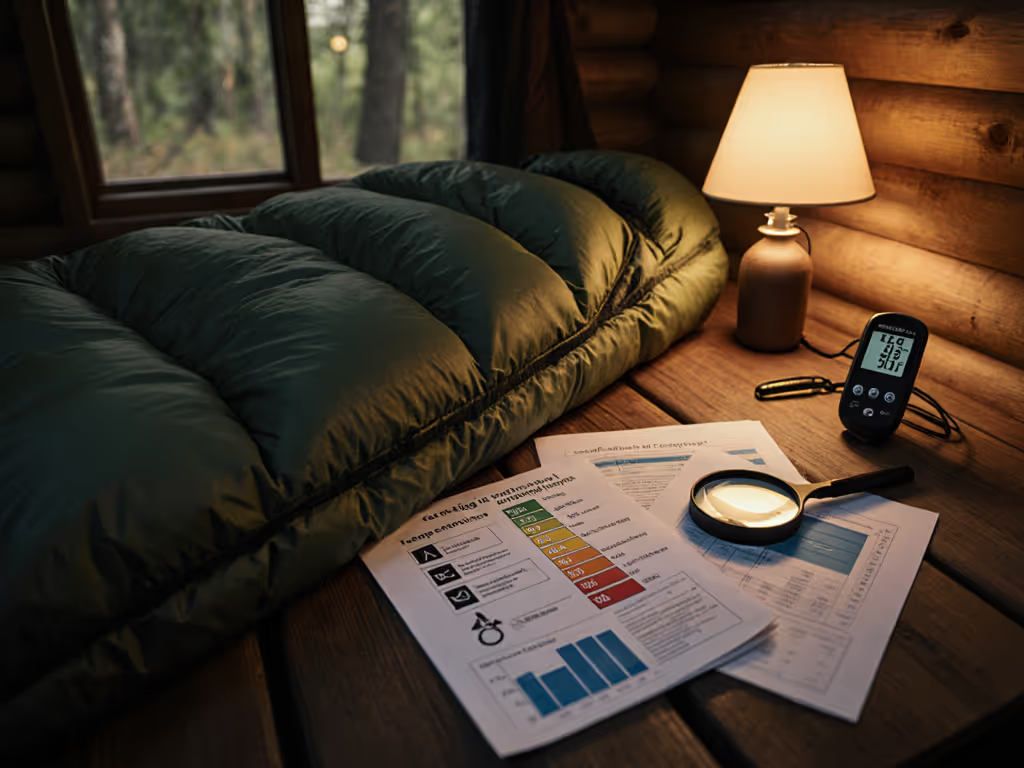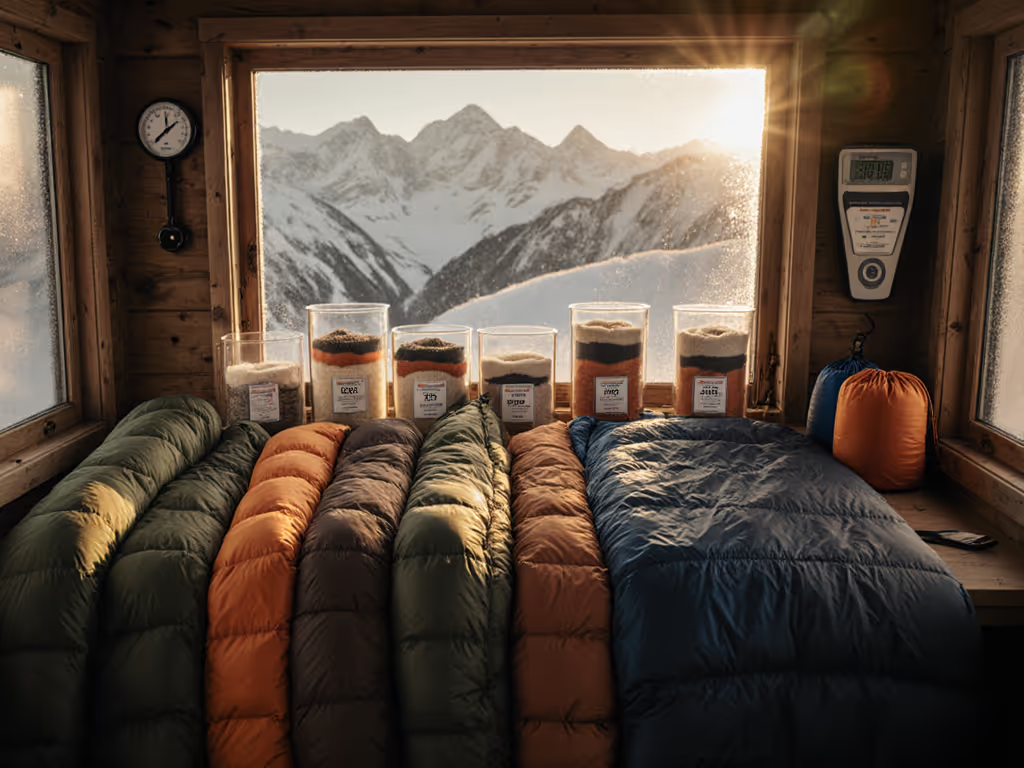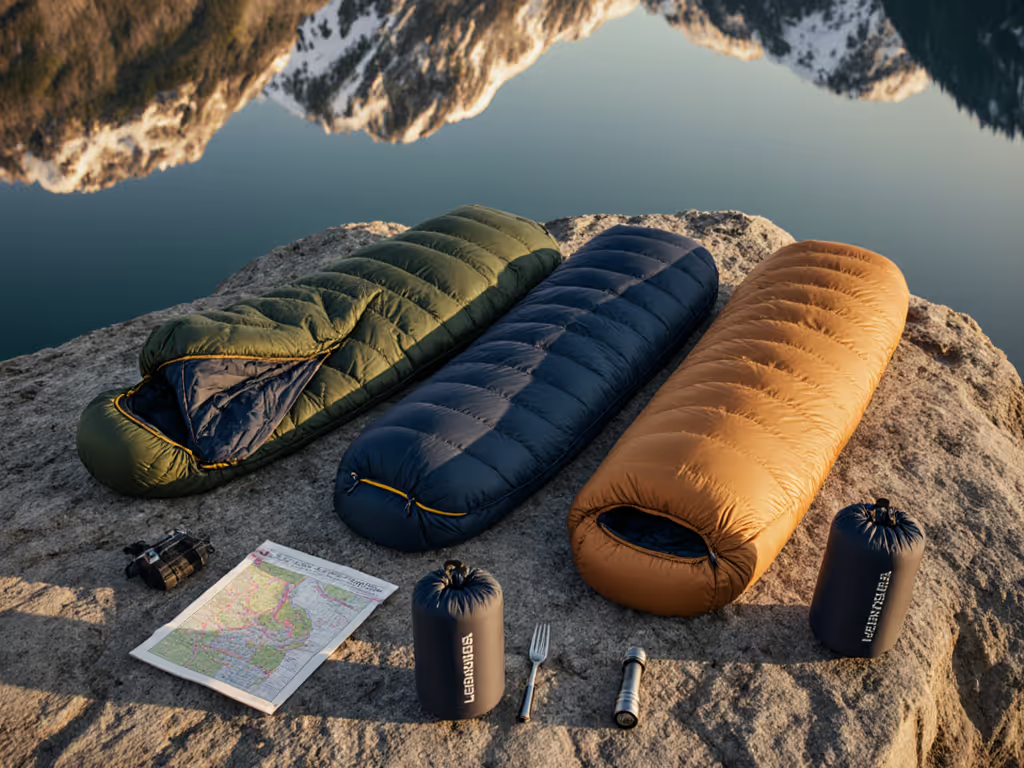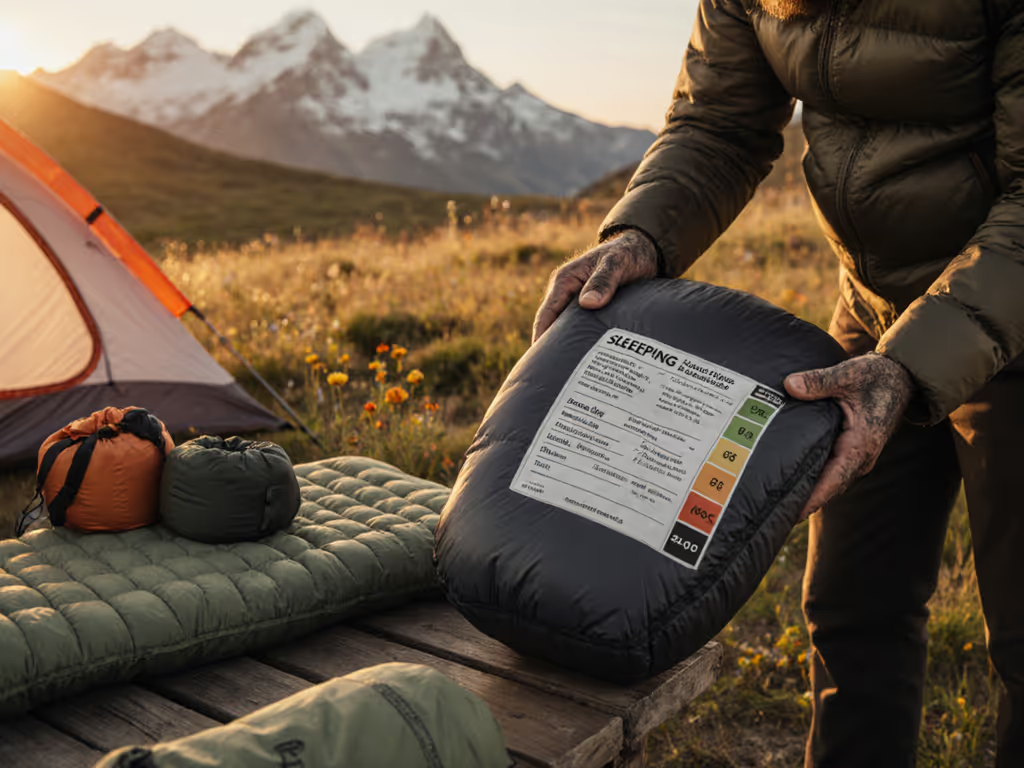
Backpacker's Guide to Sleeping Bags (Updated 2025-11-12): Decode ISO Ratings, Real-World Warmth, Weight & Eco Picks
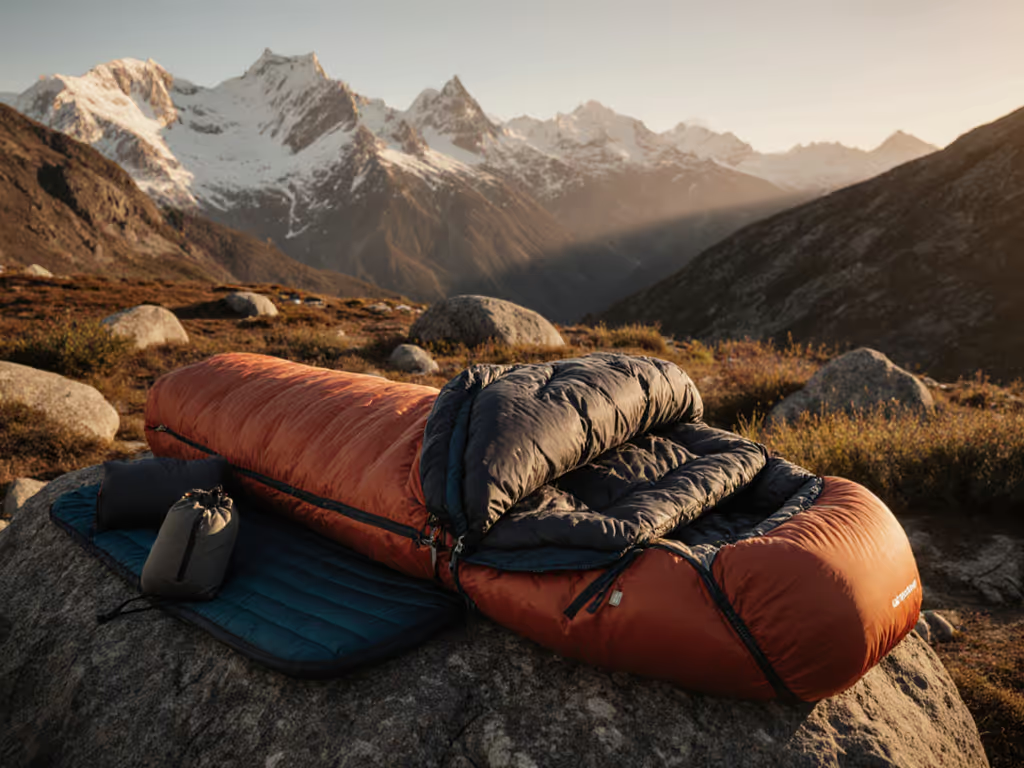
Backpacker's Guide to Sleeping Bags (Updated 2025-11-12): Decode ISO Ratings, Real-World Warmth, Weight & Eco Picks
Backpacker's Guide to Sleeping Bags (Updated 2025-11-12): Decode ISO Ratings, Real-World Warmth, Weight & Eco Picks
Choosing a sleeping bag should feel exciting, not like deciphering a cold lab report. This blog post for 2025-11-12 is your updated field manual for translating standards and specs into comfortable nights from alpine start to desert dawn. You will learn how International Organization for Standardization guidance connects to your body type, why a pad’s Thermal Resistance rating and bag fit can matter as much as fill power, and how to balance ounces with warmth without risking shivers. Throughout, Backpacker Sleep guides you with plain-language explanations, real-world testing notes, and practical eco advice so you invest in a bag that truly suits your trips.
Why this blog post for 2025-11-12 matters for your next trip
Many backpackers feel overwhelmed because the decision is a three-way tug between warmth, weight, and comfort while the weather, humidity, and your physiology all keep moving the target. You read a tag, see multiple numbers, and then wonder if the Limit figure or the Comfort figure is the one that will keep you asleep, and whether a few extra ounces might be worth the insurance at 2 a.m. on a windy ridgeline. Based on our reviews, controlled testing, and reader correspondence, most dissatisfaction stems from bags that were not warm enough for the person or pad used. By decoding ratings, fit, and system matching, this guide reduces that uncertainty so you can pick a bag with confidence.
To make this actionable, we tackle the most misunderstood elements and convert them into clear decisions you can make at home in under an hour. You will see how ISO [International Organization for Standardization] 23537 numbers map to real nights, why down and synthetic trade-offs shift with climate, and how a correctly sized bag, proper hood, and draft management can add surprising warmth without adding bulk. We also include sustainability insights so you can support responsible sourcing such as RDS [Responsible Down Standard] down and PFAS [Per- and Polyfluoroalkyl Substances]-free DWR [Durable Water Repellent] treatments. By the end, you will have a shortlist tailored to your tolerance for cold, your terrain, and your packing style.
- Skip the guesswork by matching standards to your actual sleep behavior.
- Balance warmth-to-weight with climate, shelter type, and route plan.
- Choose responsible materials without giving up performance.
ISO [International Organization for Standardization] 23537 ratings, translated: comfort vs limit vs extreme
Sleeping bag tags often show three numbers because the ISO [International Organization for Standardization] 23537 standard describes different scenarios rather than one absolute truth. Comfort approximates a typical cold sleeper who wants a relaxed posture, Limit targets a typical warm sleeper in a curled posture, and Extreme frames survival, not rest, for a limited time; if you have ever treated the Limit number like your nightly target, think of it like a speed limit instead of your cruise control. Industry testing and Backpacker Sleep's controlled lab and field testing and Real Warmth Index modeling indicate many cold sleepers stay happiest when they choose a Comfort rating at or just below their expected low, while warm sleepers often do fine selecting a bag whose Comfort is about 5 Fahrenheit degrees below forecast. Importantly, earlier EN [European Norm] 13537 results are broadly comparable, but modern ISO [International Organization for Standardization] protocols tightened variability and clarified definitions.
Watch This Helpful Video
To help you better understand blog post for 2025-11-12, we've included this informative video from Jonathan Joly. It provides valuable insights and visual demonstrations that complement the written content.
Because real nights are messy, you should add real-world buffers around lab values to protect sleep quality. We commonly advise cold sleepers to add 10 Fahrenheit degrees to their target Comfort number for shoulder seasons, especially in humid zones where convective heat loss and damp fabric can nibble at margins, and warm sleepers to carry a 5 Fahrenheit degree buffer if storms are possible. Common return reasons reported anecdotally and patterns we observe in reader correspondence and testing show that most returns in the three-season range reference sleeping colder than expected, which supports building in a margin, particularly if your sleeping pad has low R-value [Thermal Resistance] or your shelter is drafty. Use the table below as a fast translator between tag and tent.
| ISO [International Organization for Standardization] Term | What It Means | Typical Sleeper | Layering Assumed | Backpacker Sleep Tip |
|---|---|---|---|---|
| Comfort | Temp where a cold sleeper should sleep comfortably in a relaxed position. | Cold or average sleeper | Base layers, warm hat, adequate pad | Use as your primary target; add 5 to 10 F buffer if unsure. |
| Limit | Temp where a warm sleeper can maintain sleep in a curled position. | Warm sleeper | Base layers, efficient mummy fit | Treat as the lowest edge for experienced warm sleepers only. |
| Extreme | Survival threshold for a cold sleeper for several hours. | No one should target this for comfort | Emergency only | Ignore for purchasing; never plan trips at this number. |
Down vs synthetic insulation: choosing by climate, weight, and budget
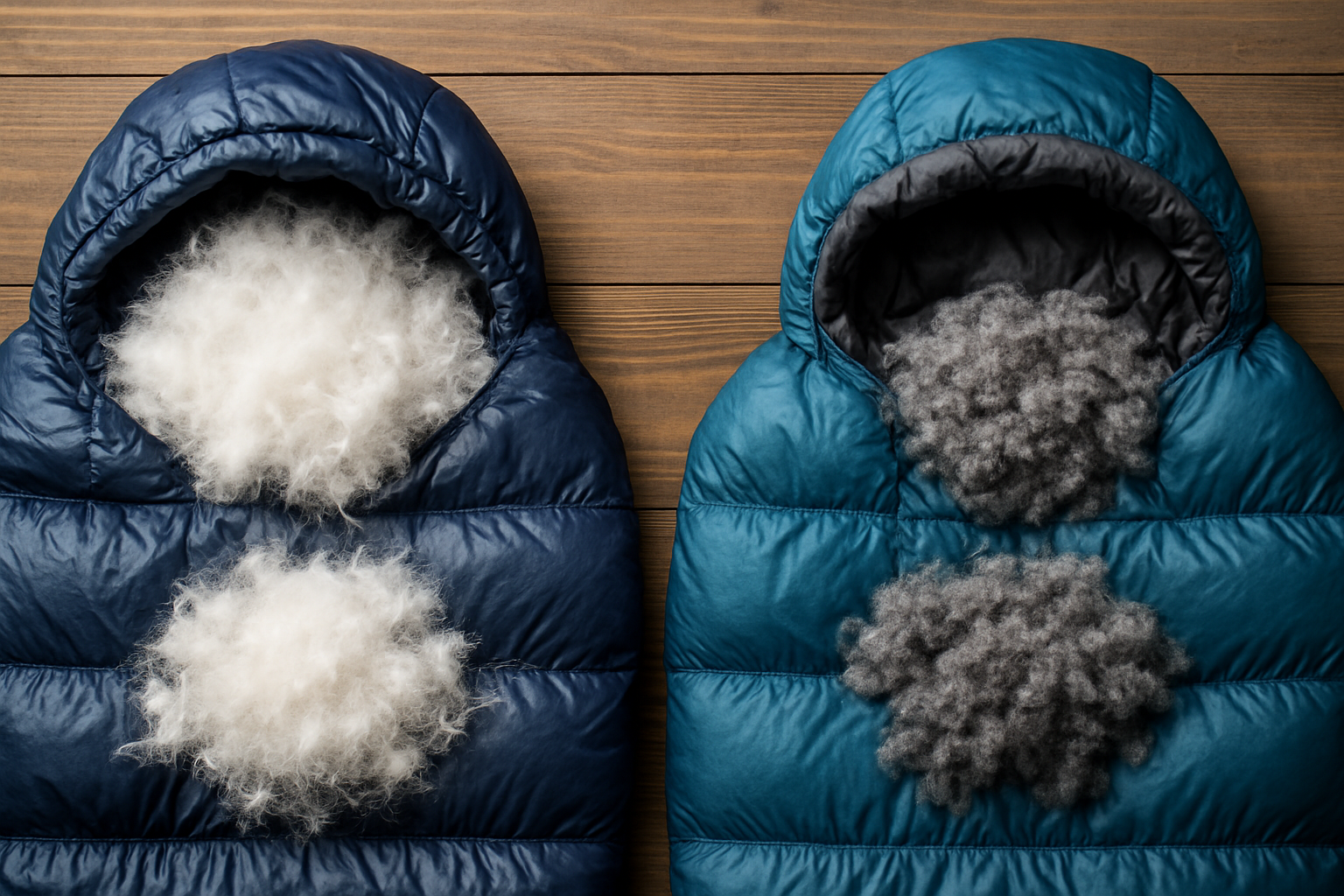
Down remains the warmth-to-weight champion due to its exceptional loft for every ounce, compressing small and rebounding well if properly cared for and protected from persistent moisture. High fill power down creates bigger air pockets for insulation and allows lighter baffle designs, but dampness flattens loft and prolonged humidity can reduce performance unless you pair with strong moisture management, a shelter with decent ventilation, and disciplined airing in sunbreaks. Synthetic fibers continue to improve, keeping more warmth when wet and drying faster, which matters for coastal routes, frequent condensation, or trips without reliable sun, yet they usually weigh more for the same warmth and pack larger. For many hikers, the best choice hinges on risk tolerance and trip pattern, with down favored for long, dry high routes and synthetic prioritized for wet forests, river trips, and budget-friendly weekenders. For a head-to-head breakdown, see our down vs synthetic comparison.
Ethical and chemical considerations increasingly guide insulation choices, and they do not have to be confusing. Look for RDS [Responsible Down Standard] certification on down to ensure animal welfare, and consider hydrophobic down treatments that are PFAS [Per- and Polyfluoroalkyl Substances]-free when available to reduce reliance on persistent chemicals; likewise, recycled synthetic insulation certified to GRS [Global Recycled Standard] reduces virgin plastic demand. Shell fabrics treated with PFC [Perfluorinated Compounds]-free DWR [Durable Water Repellent] have improved significantly over the last two years, performing closely to older chemistries in many conditions, especially when you maintain them properly with wash-in refreshers approved by bluesign. The comparison table below distills how these choices play out under headlamp reality.
| Criteria | Down | Synthetic | Backpacker Sleep Guidance |
|---|---|---|---|
| Warmth to Weight | Excellent | Good to Fair | Choose down for multi-day elevation gains where ounces compound. |
| Performance When Wet | Weak, improves with hydrophobic treatments | Good | Pick synthetic for humid zones, splashy packrafts, or foggy forests. |
| Durability | Very durable if kept clean and dry | Good, fibers slowly compact over years | Rotate storage loose at home to maintain loft. |
| Eco Considerations | RDS [Responsible Down Standard], byproduct of food industry | GRS [Global Recycled Standard] recycled options available | Verify PFAS [Per- and Polyfluoroalkyl Substances]-free DWR [Durable Water Repellent] claims. |
| Cost | Higher, scales with fill power | Lower to mid | Midrange recycled synthetic is great for entry kits. |
| Packed Size | Small | Larger | Down compresses best in small packs or bikepacking. |
Fit, shape, and sleep system: dialing bag, pad R-value [Thermal Resistance], and humidity
Fit is warmth you do not have to carry in extra fill, because dead air is surprisingly hard to heat at 3 a.m. A mummy bag with a thoughtfully contoured hood, a draft collar that seals without choking, and a zipper draft tube that actually stays aligned will trap heat efficiently, while a too-roomy rectangle can feel cozy in camp yet bleed heat along shoulders and hips. Quilts save weight and excel for side sleepers or warm conditions by letting you fine tune venting like a thermostat, but they rely heavily on a high enough pad R-value [Thermal Resistance] and a reliable strap system to prevent cold air sneaking in during toss-and-turn nights. Whichever shape you pick, treat it as one part of a sleep system with your pad, base layers, and shelter airflow all contributing to comfort.
The pad under you often decides whether a 20 Fahrenheit degree bag feels like a 20 or a 30, because ground conduction steals heat efficiently and quietly. Our field notes show that raising pad R-value [Thermal Resistance] by about one step can feel like adding roughly 5 Fahrenheit degrees of warmth to your bag, while damp fabric or low ventilation can subtract similar amounts; that is why climbers obsess over site selection and venting, even when their gear is dialed. To match forecast lows to pad choice quickly, use the guide below and remember that personal metabolism, altitude, and humidity can shift your target a bit. Add a lightweight vapor barrier liner for very cold and dry trips if you are experienced and understand moisture management, otherwise prioritize an adequate hood, clean dry base layers, and a night-time routine that includes a warm drink and a short walk to boost core heat before bed.
| Night Low (F) | Suggested Pad R-value [Thermal Resistance] | Notes |
|---|---|---|
| 50 to 40 | 2 to 3 | Fair weather three-season; quilts work well with straps. |
| 40 to 30 | 3 to 4 | Shoulder season; add a hat and seal the draft collar. |
| 30 to 20 | 4 to 5 | Three-season mountains; consider a warmer hood and socks. |
| 20 to 10 | 5 to 6+ | Late shoulder into winter; double pads or closed-cell foam booster. |
Mini case study: On a wet three-night loop in the Pacific Northwest, two hikers carried the same 20 Fahrenheit degree down mummy with PFAS [Per- and Polyfluoroalkyl Substances]-free DWR [Durable Water Repellent] shells; the cold sleeper paired a 5.7 R-value [Thermal Resistance] pad and slept warmly, while the warm sleeper used a 3.2 R-value [Thermal Resistance] pad and reported chills until adding a puffy jacket and tightening the hood. The lesson is simple yet powerful, because your bag cannot win if your pad leaks heat into the ground all night. Backpacker Sleep emphasizes system thinking in every review, mapping likely comfort outcomes for both warm and cold sleepers in realistic setups. If you treat bag, pad, and layers as a team, you will feel like you packed a heavier bag without actually carrying extra ounces.
Sustainability that still keeps you warm: eco picks and care that last
Eco-friendly does not have to mean colder nights, and the market now includes excellent bags with RDS [Responsible Down Standard] down, GRS [Global Recycled Standard] synthetic insulation, and PFC [Perfluorinated Compounds]-free DWR [Durable Water Repellent] shells that repel dew and condensation effectively when maintained. Explore our trusted eco-friendly sleeping bag picks to see top models that balance sustainability and field performance. Life cycle thinking matters because a high-quality bag that lasts ten years often beats a cheaper alternative replaced twice, and LCA [Life Cycle Assessment] studies consistently show durability as a key driver of lower long-term impact; in other words, buy once, care well, and repair if you can. You can extend life by storing bags uncompressed at home, laundering with down-safe or synthetic-safe detergents, restoring DWR [Durable Water Repellent] as needed, and repairing small snags before they propagate along stitch lines. When shopping, look for transparent material claims and third-party certifications, and remember that warmth-to-weight efficiency can itself be an eco benefit because it reduces the overall materials and energy required to achieve a performance goal.
Backpacker Sleep highlights sustainability attributes alongside warmth and fit so you can see trade-offs in context rather than in isolation. We call out PFAS [Per- and Polyfluoroalkyl Substances]-free finishes, recycled content, and traceable sourcing, but we also stress how these features perform on trail in fog, frost, and spindrift, because your principles and your sleep both matter. Brands increasingly print chemical disclosure summaries and repair instructions on hangtags, and some offer take-back programs you can actually use, which is encouraging for long-haul ownership. If you align your purchase with credible standards and adopt a slightly more meticulous care routine, you gain the best of both worlds: quieter conscience and warmer nights.
| Eco Label | What It Ensures | Why It Matters on Trail |
|---|---|---|
| RDS [Responsible Down Standard] | Animal welfare and supply chain traceability for down. | Ethics plus consistent loft quality for reliable warmth. |
| GRS [Global Recycled Standard] | Verified recycled content and responsible processing. | Less virgin plastic, often with competitive performance. |
| PFAS [Per- and Polyfluoroalkyl Substances]-free DWR [Durable Water Repellent] | Water repellency without persistent chemicals. | Manages dew and condensation while reducing environmental harm. |
Quick comparison tables and a confident shortlist

You might be wondering how all of this merges into a practical shortlist you can act on before your next permit window. Start by pegging your coldest realistic night, add your personal buffer, match a bag style to your sleep posture, and then check that your pad R-value [Thermal Resistance] and shelter setup support the plan; if you tend to wake cold at home, honor that pattern in the backcountry. Backpacker Sleep maintains comprehensive reviews segmented by temperature class and expected conditions, with side-by-side comparisons and plain-English verdicts on who will love or leave each bag. The table below offers a neutral template to jumpstart your choices, and our full reviews expand each category with specific models, caveats, and eco notes so you can finalize with clarity rather than guesswork.
| Category | Target Comfort | Typical Weight | Insulation | Best For | Eco Angle |
|---|---|---|---|---|---|
| Summer Quilt | 45 to 35 F | 12 to 20 oz | Down or Recycled Synthetic | Warm sleepers, dry climates, low pack volume | GRS [Global Recycled Standard] synthetic or RDS [Responsible Down Standard] down |
| 3-Season Mummy | 30 to 20 F | 24 to 34 oz | 650 to 900 fill down or advanced synthetic | Mixed climates, alpine starts, shoulder seasons | PFAS [Per- and Polyfluoroalkyl Substances]-free DWR [Durable Water Repellent] shell |
| Wet-Climate Synthetic | 35 to 25 F | 30 to 42 oz | High-loft recycled fibers | Coastal forests, river corridors, condensation-prone tents | GRS [Global Recycled Standard] fill, repair-friendly stitch layout |
| Light Winter Down | 15 to 5 F | 32 to 48 oz | High fill power down with draft collar | Dry cold, snow camping with double-pad system | RDS [Responsible Down Standard] down, long-term repairability |
- Checklist before you buy:
- Forecast your coldest realistic night and add a personal buffer.
- Match bag type to posture and shoulder width for minimal dead air.
- Confirm pad R-value [Thermal Resistance] meets the temperature target.
- Decide on down vs synthetic using your climate and drying opportunities.
- Verify eco claims: RDS [Responsible Down Standard], GRS [Global Recycled Standard], and PFAS [Per- and Polyfluoroalkyl Substances]-free DWR [Durable Water Repellent].
- Plan a quick shakedown night to validate warmth and venting.
How Backpacker Sleep turns lab data into cozy nights
Backpacker Sleep exists to translate ISO [International Organization for Standardization] and lab terminology into the plain decisions that keep you warm on the ground. Our comprehensive reviews on sleeping bags for various conditions crosswalk Comfort and Limit numbers with realistic pad choices, shelter styles, and layering examples so you see how a tag becomes a night’s sleep for your body type. Detailed guides pair insulation types with specific climates and trip lengths, explain baffle patterns and overfill in simple analogies, and include humidity management routines you can actually remember after a long day. Because ethics and environment matter, we prioritize eco-friendly and sustainable options and spotlight repairability, packability, and care methods that extend usable life without compromising safety.
We repeatedly test fit because a well-shaped hood, a non-snag draft tube, and a collar that seals easily add surprising warmth without adding grams. In each review you will find explicit notes on sizing, zipper placement, venting ease, and footbox shape, plus best practices for pairing bags with pads of differing R-value [Thermal Resistance], because a stellar bag on a too-thin pad is a recipe for disappointment. Our goal is simple: replace guesswork with grounded, trail-proven guidance, so you can sleep deeply and wake ready to move. When you are ready for specifics, our side-by-side tables and scenario-based picks make the shortlist obvious, whether you are chasing fast miles or leisurely campfire stories.
Key takeaways at a glance:
- Use Comfort as your anchor and add a personal buffer based on your sleep style.
- Pick insulation based on climate moisture and drying opportunities, not just weight.
- Ensure pad R-value [Thermal Resistance] aligns with the coldest night you expect.
- Choose credible eco certifications and adopt a simple care routine for longevity.
- Lean on Backpacker Sleep for side-by-side clarity before you click buy.
Conclusion
Sleep smarter by translating standards into comfort, then matching your bag, pad, and layers for the exact nights you plan to face.
Imagine the next 12 months with fewer shivers, lighter packs, and an upgrade in trail mornings because you picked a bag that suits your climate, metabolism, and ethics. What would you explore if every bivy felt like a trusted home away from home in your blog post for 2025-11-12?
Level Up Your Blog Post For 2025-11-12 With Backpacker Sleep
Get comprehensive reviews for every condition plus clear ISO [International Organization for Standardization] explanations, fit and insulation guidance, and eco picks to help backpackers, hikers, and campers choose confidently.

